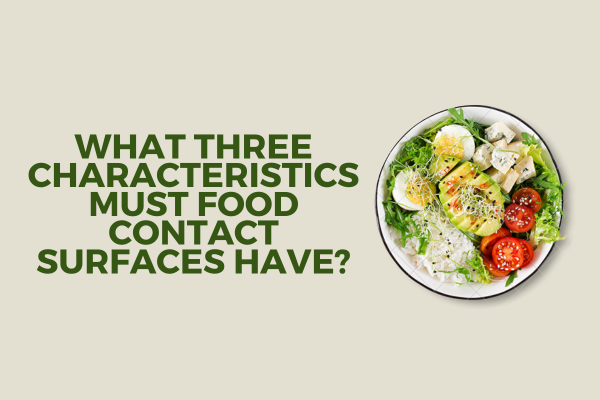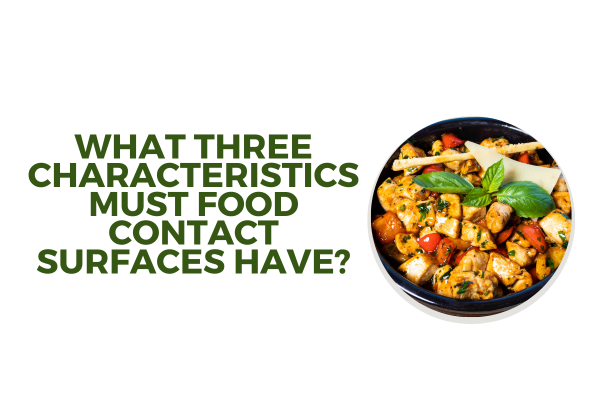Introduction: What Three Characteristics Must Food Contact Surfaces Have?
Food safety is of utmost importance in every step of the food supply chain, from production to consumption. One critical aspect of ensuring food safety is maintaining clean and hygienic food contact surfaces. Food contact surfaces refer to any surfaces that come into direct contact with food during processing, preparation, storage, or serving.
In this article, we will delve into the essential characteristics that food contact surfaces must have to promote food safety and prevent contamination. By understanding these characteristics, we can take the necessary precautions and adopt best practices to protect consumers’ health. So, what three characteristics must food contact surfaces have? Let’s find out!
What Three Characteristics Must Food Contact Surfaces Have?
When it comes to food contact surfaces, three key characteristics are essential for maintaining food safety and preventing cross-contamination. Let’s explore each characteristic in detail:
1. Cleanability
Cleanability is the foremost characteristic that food contact surfaces must possess. Surfaces should be easy to clean and sanitize effectively, minimizing the risk of bacterial growth and contamination. Proper cleaning removes food residues, grease, and other contaminants that can harbor harmful microorganisms.
To achieve optimal cleanability, food contact surfaces should be smooth, non-porous, and free from cracks or crevices that could trap food particles or bacteria. Smooth surfaces are easier to clean and sanitize compared to rough or textured surfaces. Additionally, selecting materials that are resistant to staining and corrosion can enhance cleanability and prolong the lifespan of the surfaces.
2. Durability
Durability is another vital characteristic for food contact surfaces. These surfaces endure frequent use, cleaning, and exposure to various chemicals and temperatures. They must withstand the rigors of daily operations without deteriorating or becoming damaged, as compromised surfaces can harbor bacteria and pose a risk to food safety.
Choosing materials with high durability, such as stainless steel or food-grade plastic, is crucial. These materials are resistant to wear, corrosion, and impact, ensuring that the surfaces remain intact and free from damage. Regular maintenance and inspections are also necessary to identify any signs of wear or degradation promptly.
3. Non-Toxicity
The third essential characteristic of food contact surfaces is non-toxicity. These surfaces should not release harmful substances or chemicals into the food, ensuring that the food remains safe and free from contamination. It is essential to select materials that comply with regulations and industry standards, such as FDA-approved materials for food contact.
Materials that are known to be safe for food contact include stainless steel, certain plastics (e.g., polyethylene and polypropylene), glass, and food-grade silicone. These materials do not impart taste, odor, or harmful substances to the food, ensuring its integrity and safety. Regular monitoring and testing can further confirm the non-toxic nature of the materials used for food contact surfaces.
FAQs About: What Three Characteristics Must Food Contact Surfaces Have?
To provide a comprehensive understanding of the topic, let’s address some frequently asked questions regarding food contact surfaces:
1. Are wooden cutting boards considered safe food contact surfaces?
Wooden cutting boards can be safe food contact surfaces if they are properly maintained. However, they require meticulous cleaning and sanitizing due to their porous nature. Regular oiling and thorough washing after each use are necessary to prevent the growth of bacteria.
2. Is it necessary to replace food contact surfaces periodically?
Yes, it is essential to replace food contact surfaces periodically, especially if they show signs of wear, damage, or degradation. Regular inspections should be conducted, and surfaces should be replaced when they no longer meet the required standards of cleanliness, durability, or non-toxicity.
3. What cleaning agents should be used for food contact surfaces?
Cleaning agents suitable for food contact surfaces include mild detergents, sanitizers, and disinfectants approved for such use. It is crucial to follow the manufacturer’s instructions and ensure that the cleaning agents do not leave harmful residues on the surfaces.
4. Can food contact surfaces be made from recycled materials?
Yes, food contact surfaces can be made from recycled materials, provided that the materials meet regulatory requirements and undergo proper processing to ensure their safety and non-toxicity. It is essential to ensure that recycled materials do not introduce contaminants into the food.
5. How often should food contact surfaces be cleaned and sanitized?
Food contact surfaces should be cleaned and sanitized regularly, following a predetermined schedule. The frequency of cleaning depends on the intensity of use and the specific requirements of the food establishment. Typically, surfaces should be cleaned after each use, and additional sanitization may be required periodically or when handling different food types.
6. Can food contact surfaces be repaired if they become damaged?
In some cases, damaged food contact surfaces can be repaired. However, it is crucial to consult with experts and follow industry guidelines. Minor damages can often be repaired, while significant structural or material defects may necessitate surface replacement to maintain food safety.
Conclusion
Ensuring the safety of food contact surfaces is vital for maintaining food safety and preventing contamination. The three essential characteristics that these surfaces must possess the clean-ability, durability, and non-toxicity—play a crucial role in safeguarding consumers’ health. By selecting materials that are easy to clean, durable, and non-toxic, food establishments can meet industry standards and regulations. Regular cleaning, maintenance, and inspections are necessary to ensure the ongoing integrity of food contact surfaces. Remember, prioritising food safety not only protects consumers but also upholds the reputation and success of food-related businesses.
Visit the link to read more:
https://family-fitness-fun.com/the-ultimate-guide-food-that-makes-people-sick-will-often/





